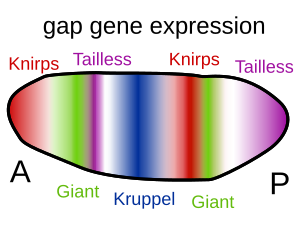Gene control of differentiation in ontogeny
Gene control[edit | edit source]
Fertilization produces a zygote from the two gametes, and a morula from the grooving one. As the cells travel out, a blastula is formed and then a gastrula (three germ layers) is formed. This is followed by the development of the primitive streak, organogenesis and histogenesis.
During ontogeny, the following mechanisms apply:
- cell growth, cell division, migration cells,
- differentiation cells,
- apoptosis.
All cells in the body have the same set of genes, but differ in their expression.
Ontogenesis = sequence of events that is initiated by fertilization - regulatory cascade (local mediators, hormones, receptors, transcription factors, etc. are used here)
Morphogenes = control the differentiation and predetermination of cells, their action depends on the concentration of their products - they create a concentration gradient where the effect occurs only from places where the concentration reaches a certain threshold level. Their cascade is already activated before fertilization
Maternal Way Genes[edit | edit source]
- They are part of the mother's genome,
- expressed in follicular bb and their mRNA and proteins transported to the egg,
- in their mutations, the zygote dies independently of its genotype,
- they determine the anterioposterior and dorsoventral polarity of the embryo,
- this includes bicoid (determines where the front of the embryo is) and nanos (determines the back of the embryo),
- works in collaboration with hunchback gene.
Genes of the zygote[edit | edit source]
Segmentation genes[edit | edit source]
- In vertebrates, the segments are distinct only in the initial stages of development.
Gap genes[edit | edit source]
- E.g. hunchback, knirps, giant a krüpl,
- genes of maternal origin are activated,
- their mutation: developmental disorder of part of the segments,
- they are transcription factors,
- affect the basic differentiation of the embryo.
HOX genes[edit | edit source]
- They contain a homeodomain (homeobox)
- Their mutations can cause one organ to be confused with another,
- bithorax and antenapedia complex genes,
- mutation of the antenapedia gene in Drosophila melanogaster causes the development of a leg on the head instead of a antennae,
- in humans, HOX1 mutation causes craniosynostosis.
Pair-rule genes (PAX)[edit | edit source]
- They also contain a homeodomain (homeobox)
- They specify the nature of the segments,
- regulated by gap genes,
- expressed in 7 stripes along the anterioposterior axis,
- they divide the embryo into 15 parasegments,
- their mutations reduce the number of segments by half (fushi tarazu - development of odd parasegments, even-skipped - development of even parasegments),
- PAX3 mutation = Waardenburg syndrome (deafness, white strand of hair, iris heterochromia).
(Para)segment polarity genes[edit | edit source]
- They influence the anterioposterior polarity of parasegments, defined by pair-rule genes,
- the embryo is gradually divided into smaller and smaller developmental sections,
- e.g. engrailed gen.
Tissue-specific genes[edit | edit source]
- A cascade of hundreds of genes,
- eyeless gene - its mutation in Drosophila causes the development of a rudimentary eye, in mice microophthalmia and in humans aniridia,
- when the eyeless gene is linked to the promoter of a gene typical for another tissue, an eye develops in this tissue,
- with interspecies transfer of the eyeless gene, a species-specific eye is created → basic tissue-specific genes are developmentally old,
- other, developmentally younger and species-specific genes also decide on the definitive form of the organ.
The spectrum of genes that is expressed in a certain type of cells is determined by RNA - DNA saturation.
Links[edit | edit source]
Used literature[edit | edit source]
- KAPRAS, Jan – KOHOUTOVÁ, Milada. Kapitoly z lékařské genetiky III.. 1. edition. Karolinum, 2009. vol. 1. ISBN 80-246-0001-3.



